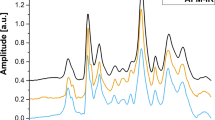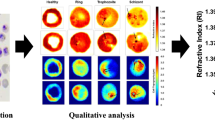Abstract
Malaria is one the most devastating infectious diseases in the world: of the five malaria-associated parasites, Plasmodium falciparum and P. vivax are the most pathogenic and widespread, respectively. P. falciparum invades human red blood cells (RBCs), releasing extracellular vesicles (Pf-EV) carrying DNA, RNA and protein cargo components involved in host-pathogen communications in the course of the disease. Different strategies have been used to analyze Pf-EV biophysically and chemically. Atomic force microscopy (AFM) stands out as a powerful tool for rendering high quality images of extracellular vesicles. In this technique, a sharp tip attached to a cantilever reconstructs the topographic surface of the extracellular vesicles and probes their nano-mechanical properties based on force–distance curves. Here, we describe a method to separate Pf-EV using differential ultracentrifugation, followed by nanoparticle tracking analysis (NTA) to quantify and estimate the size distribution. Finally, the AFM imaging procedure on Pf-EV adsorbed on a Mg2+-modified mica surface is detailed.
Access this chapter
Tax calculation will be finalised at checkout
Purchases are for personal use only
Similar content being viewed by others
References
Ben-Hur S, Biton M, Regev-Rudzki N (2018) Extracellular vesicles: a prevalent tool for microbial gene delivery? Proteomics 19:e1800170
Ofir-Birin Y, Regev-Rudzki N (2019) Extracellular vesicles in parasite survival. Science 363:817–818
Rivkin A, Ben-Hur S, Regev-Rudzki N (2017) Malaria parasites distribute subversive messages across enemy lines. Trends Parasitol 33:2–4
Babatunde KA, Yesodha Subramanian B, Ahouidi AD et al (2020) Role of extracellular vesicles in cellular cross talk in malaria. Front Immunol 11:22
Toda H, Diaz-Varela M, Segui-Barber J et al (2020) Plasma-derived extracellular vesicles from Plasmodium vivax patients signal spleen fibroblasts via NF-kB facilitating parasite cytoadherence. Nat Commun 11:2761
Demarta-Gatsi C, Rivkin A, Di Bartolo V et al (2019) Histamine releasing factor and elongation factor 1 alpha secreted via malaria parasites extracellular vesicles promote immune evasion by inhibiting specific T cell responses. Cell Microbiol 21:e13021
Regev-Rudzki N, Wilson DW, Carvalho TG et al (2013) Cell-cell communication between malaria-infected red blood cells via exosome-like vesicles. Cell 153:1120–1133
Dekel E, Yaffe D, Rosenhek-Goldian I et al (2021) 20S proteasomes secreted by the malaria parasite promote its growth. Nat Commun 12:1172
Mantel PY, Hoang AN, Goldowitz I et al (2013) Malaria-infected erythrocyte-derived microvesicles mediate cellular communication within the parasite population and with the host immune system. Cell Host Microbe 13:521–534
Sisquella X, Ofir-Birin Y, Pimentel MA et al (2017) Malaria parasite DNA-harbouring vesicles activate cytosolic immune sensors. Nat Commun 8:1985
Mantel PY, Hjelmqvist D, Walch M et al (2016) Infected erythrocyte-derived extracellular vesicles alter vascular function via regulatory Ago2-miRNA complexes in malaria. Nat Commun 7:12727
Antwi-Baffour S, Malibha-Pinchbeck M, Stratton D et al (2020) Plasma mEV levels in Ghanain malaria patients with low parasitaemia are higher than those of healthy controls, raising the potential for parasite markers in mEVs as diagnostic targets. J Extracell Vesicles 9:1697124
Dekel E, Rivkin A, Heidenreich M et al (2017) Identification and classification of the malaria parasite blood developmental stages, using imaging flow cytometry. Methods 112:157–166
Ofir-Birin Y, Abou Karam P, Rudik A et al (2018) Monitoring extracellular vesicle cargo active uptake by imaging flow cytometry. Front Immunol 9:1011
Ketprasit N, Cheng IS, Deutsch F et al (2020) The characterization of extracellular vesicles-derived microRNAs in Thai malaria patients. Malar J 19:285
Thery C, Witwer KW, Aikawa E et al (2018) Minimal information for studies of extracellular vesicles 2018 (MISEV2018): a position statement of the International Society for Extracellular Vesicles and update of the MISEV2014 guidelines. J Extracell Vesicles 7:1535750
Radfar A, Mendez D, Moneriz C et al (2009) Synchronous culture of Plasmodium falciparum at high parasitemia levels. Nat Protoc 4:1899–1915
Rupert DLM, Claudio V, Lasser C et al (2017) Methods for the physical characterization and quantification of extracellular vesicles in biological samples. Biochim Biophys Acta Gen Subj 1861:3164–3179
Hartjes TA, Mytnyk S, Jenster GW et al (2019) Extracellular vesicle quantification and characterization: common methods and emerging approaches. Bioengineering (Basel) 6:7
Binnig G, Quate CF, Gerber C (1986) Atomic force microscope. Phys Rev Lett 56:930–933
Cappella B, Dietler G (1999) Force-distance curves by atomic force microscopy. Surf Sci Rep 34:1–104
Quintanilla MAS (2013) Surface analysis using contact mode AFM. In: Wang QJ, Chung Y-W (eds) Encyclopedia of tribology. Springer, Boston, MA, pp 3401–3411
Radmacher M, Fritz M, Hansma PK (1995) Imaging soft samples with the atomic force microscope: gelatin in water and propanol. Biophys J 69:264–270
Elings VB, Gurley JA (1995) Tap** atomic force microscope. Digital Instruments, Inc, Santa Barbara, CA
Xu K, Sun W, Shao Y et al (2018) Recent development of PeakForce Tap** mode atomic force microscopy and its applications on nanoscience. Nanotechnol Rev 7:605–621
Vorselen D, van Dommelen SM, Sorkin R et al (2018) The fluid membrane determines mechanics of erythrocyte extracellular vesicles and is softened in hereditary spherocytosis. Nat Commun 9:4960
Sorkin R, Huisjes R, Boskovic F et al (2018) Nanomechanics of extracellular vesicles reveals vesiculation pathways. Small 14:e1801650
Parisse P, Rago I, Ulloa Severino L et al (2017) Atomic force microscopy analysis of extracellular vesicles. Eur Biophys J 46:813–820
Hölscher H (2012) AFM, tap** mode. In: Bhushan B (ed) Encyclopedia of nanotechnology. Springer, Dordrecht, pp 99–99
Zhong Q, Inniss D, Kjoller K et al (1993) Fractured polymer/silica fiber surface studied by tap** mode atomic force microscopy. Surf Sci 290:L688–L692
Kamruzzahan ASM, Kienberger F, Stroh CM et al (2004) Imaging morphological details and pathological differences of red blood cells using tap**-mode AFM. Biol Chem 385:955–960
Sorkin R, Kampf N, Dror Y et al (2013) Origins of extreme boundary lubrication by phosphatidylcholine liposomes. Biomaterials 34:5465–5475
Magonov SN, Elings V, Whangbo MH (1997) Phase imaging and stiffness in tap**-mode atomic force microscopy. Surf Sci 375:L385–L391
Oliver WC, Pharr GM (1992) An improved technique for determining hardness and elastic modulus using load and displacement sensing indentation experiments. J Mater Res 7:1564–1583
Rosenhek-Goldian I, Cohen S (2020) Nanomechanics of biomaterials - from cells to shells. Israel J Chem 60:1–15
Deregibus MC, Figliolini F, D’antico S et al (2016) Charge-based precipitation of extracellular vesicles. Int J Mol Med 38:1359–1366
Raval J, Góźdź WT (2020) Shape transformations of vesicles induced by their adhesion to flat surfaces. ACS Omega 5:16099–16105
Chang K-C, Chiang Y-W, Yang C-H et al (2012) Atomic force microscopy in biology and biomedicine. Tzu Chi Med J 24:162–169
Stylianou A, Kontomaris S-V, Grant C et al (2019) Atomic force microscopy on biological materials related to pathological conditions. Scanning 2019:8452851
Acknowledgments
We greatly appreciate Dr. Sidney R. Cohen for his critical review of the manuscript.
Author information
Authors and Affiliations
Corresponding author
Editor information
Editors and Affiliations
Rights and permissions
Copyright information
© 2022 The Author(s), under exclusive license to Springer Science+Business Media, LLC, part of Springer Nature
About this protocol
Cite this protocol
Rosenhek-Goldian, I., Abou Karam, P., Regev-Rudzki, N., Rojas, A. (2022). Imaging of Extracellular Vesicles Derived from Plasmodium falciparum–Infected Red Blood Cells Using Atomic Force Microscopy. In: Jensen, A.T.R., Hviid, L. (eds) Malaria Immunology. Methods in Molecular Biology, vol 2470. Humana, New York, NY. https://doi.org/10.1007/978-1-0716-2189-9_12
Download citation
DOI: https://doi.org/10.1007/978-1-0716-2189-9_12
Published:
Publisher Name: Humana, New York, NY
Print ISBN: 978-1-0716-2188-2
Online ISBN: 978-1-0716-2189-9
eBook Packages: Springer Protocols




